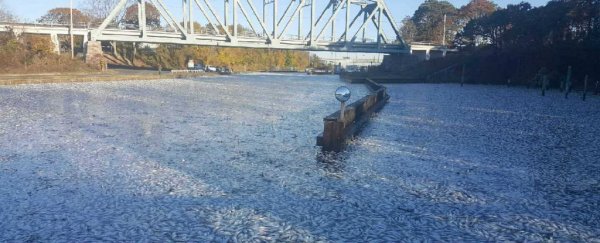Imagine waking up on a Monday morning and seeing an entire stretch of the Shinnecock Canal on Long Island filled to the brim with dead and dying fish. I'm talking thousands and thousands of fish corpses, all pilled on top of each other, stretching down the canal from wall to wall.
That's what New York locals are dealing with right now, as scientists investigate the unprecedented die-off of bunker fish that's been nicknamed the 'fishpoclypse'.
"Unbelievable scene - tonnes and tonnes of bunker starving for oxygen," Long Island resident Dennis Demarco says in the video below. "Even the locals have not seen anything like this before."
Local officials have yet to explain what actually happened here, but Demarco's explanation is currently the most popular one with scientists working on the investigation - bunker fish (also known as menhaden fish), weren't killed by a build-up of toxic algae or industrial waste - they appear to have been starved of oxygen.
Sightings of bluefish - large, aggressive, and fast-swimming predators - in and around the Shinnecock Canal just days before the die-off suggest that massive amounts of bunker fish were 'herded' into the cramped area, and then were locked in when the gates were closed for the evening.
"There was a big school of bluefish in the bay earlier on Sunday," Southampton Marine Science Centre manager Chris Paparo told CBS News.
"Bluefish eat bunker, and they chase the bunker into the canal like this, and the locks are closed, fish can't escape, and when they get pushed in they deplete the oxygen."
Here's more footage of the die-off:
"The canal is a confined area, and when the locks are closed, water isn't moving," Chris Gobler from Stony Brook University's School of Marine and Atmospheric Sciences told the Southhampton Press.
"Even when there aren't any fish in there, water is still, and the oxygen levels drop. Maybe not to fish kill levels. But when you add fish in there, that knocks the oxygen levels down even further."
Once officials had seen what had happened, they opened the canal gates to keep oxygen levels up and create a passage for some of the surviving bunker fish to escape.
They say that since the incident, no more fish deaths have been reported, so this appears to have been an isolated incident.
Efforts are now being made to clean up the thousands and thousands of rotting corpses - many of which have since sunk to the bottom of the canal - and researchers will be monitoring the movements of the dead fish from the sky to get a better idea of the extent of the die-off.
This is pretty disturbing...this was the Shinnecock canal this morning pic.twitter.com/02pvd8lCKy
— Rude Gyal (@JustineAiko) November 14, 2016
"Right now, we're in a period where we just have to wait and see whether the fish float to the top," Town trustee Scott Horowitz told the Southhampton Press. "People are going to keep an eye on it from the air and the sea. We're also going to keep an eye on the tides and prevailing winds."
While locals wait for an explanation, they've been assured that, at this stage, this is not a public health issue - but the smell can't be all that great. The odour is apparently going to be 'masked' using lime and wood chips.
There are concerns that something like this could happen again, so the canal gate operators have been told to keep them open for longer in the coming days to pump more oxygen back into the water.
The State Department of Environmental Conservation are testing the water to see if pathogens or pollution could have contributed to the incident, but Southampton town supervisor Jay Schneiderman says the fact that no one's ever seen anything like this before suggests that this was just 'one of those things'.
"We may not see this even happen in our lifetime, but we'll have a sense of what worked and what didn't," he said.
RIP, bunker fish. We hardly knew you.

